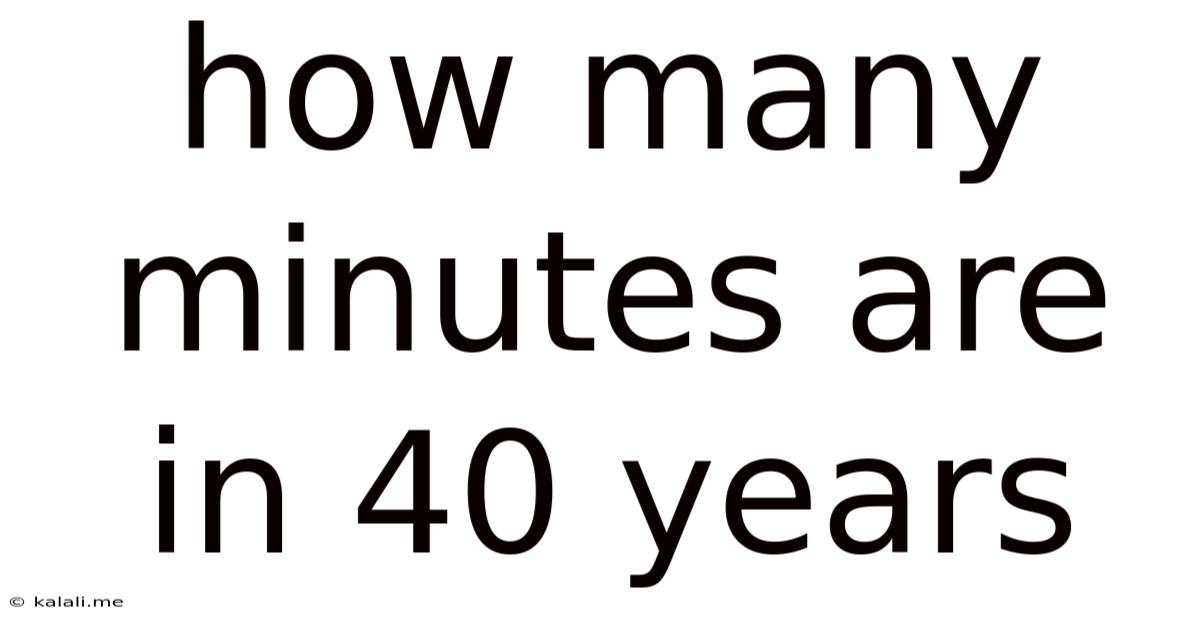How Many Minutes Are In 40 Years
Kalali
Jul 30, 2025 · 4 min read

Table of Contents
How Many Minutes Are in 40 Years? A Deep Dive into Time Calculation
This article delves into the seemingly simple question: how many minutes are in 40 years? While a quick calculation might seem sufficient, we'll explore this question in detail, examining the complexities of time calculation, considering leap years, and offering various approaches to arrive at the answer. We'll also touch upon the broader implications of understanding large time spans and their relevance in various fields. This detailed exploration will provide a comprehensive understanding beyond a simple numerical answer.
Understanding the Basics: From Years to Minutes
The core of this calculation lies in understanding the hierarchical structure of time units. We move from larger units (years) to smaller ones (minutes) using conversion factors. The fundamental conversions are:
- Years to Days: A year typically has 365 days. However, leap years introduce an extra day every four years (with exceptions for century years not divisible by 400). This irregularity is crucial for accurate calculation.
- Days to Hours: There are 24 hours in a day.
- Hours to Minutes: There are 60 minutes in an hour.
Calculating the Minutes in 40 Years: The Simple Approach (and its Inaccuracies)
The simplest approach ignores leap years and uses the average number of days in a year: 365.25. This gives us:
40 years * 365.25 days/year * 24 hours/day * 60 minutes/hour = 21,036,000 minutes
While this provides a close approximation, it's not entirely accurate because it doesn't precisely account for the variations introduced by leap years.
The More Accurate Calculation: Accounting for Leap Years
For a more precise answer, we must account for the exact number of leap years within the 40-year period. To illustrate this, let's assume our 40-year period starts on January 1st, 2024. Within this 40-year span (2024-2064), we will have:
-
Leap Years: A leap year occurs every four years, so we have 10 leap years (2024, 2028, 2032, 2036, 2040, 2044, 2048, 2052, 2056, 2060).
-
Non-Leap Years: Therefore, we have 30 non-leap years (40 total years - 10 leap years).
Now we can perform a more accurate calculation:
(30 years * 365 days/year) + (10 years * 366 days/year) * 24 hours/day * 60 minutes/hour = 21,024,000 minutes
This calculation provides a more accurate figure, reflecting the variations caused by the presence of leap years. The difference, while seemingly small, highlights the importance of precise accounting when dealing with extensive periods.
Exploring Variations: Different Starting Years
The number of leap years within a 40-year period might vary slightly depending on the starting year. This is due to the exceptions in the leap year rule (century years not divisible by 400). For instance, a 40-year period encompassing a century year not divisible by 400 will have one fewer leap year than a period without such a year. Therefore, the total number of minutes will change marginally.
Beyond the Calculation: The Significance of Time Scales
Understanding how many minutes are in 40 years transcends mere calculation; it offers insights into the vastness of time and its implications:
- Personal Time Management: Considering the sheer number of minutes in 40 years emphasizes the finite nature of our time and encourages effective time management.
- Long-Term Planning: In fields like finance, environmental science, and strategic planning, comprehending long time scales is crucial for accurate forecasting and decision-making.
- Scientific Research: In disciplines such as geology, paleontology, and cosmology, understanding and interpreting vast timescales is fundamental.
- Historical Context: A 40-year period represents a significant slice of history, enabling us to analyze trends, patterns, and societal changes.
Different Approaches and Tools for Time Calculations
While manual calculation is educational, various online tools and software are available for converting between different units of time. These tools often handle leap years automatically, providing accurate results. Learning to use these tools can save time and increase accuracy in more complex time calculations.
Considering Other Time Units
This calculation can be extended to other time units, such as seconds, weeks, months, or decades. The same principle applies: break down the time units and use the appropriate conversion factors, accounting for the variations caused by leap years.
Conclusion: Precision in Time Measurement
The question of how many minutes are in 40 years highlights the importance of precision in time calculations. While a quick estimate may suffice in many situations, understanding and accounting for variations like leap years is critical for achieving accuracy, particularly when dealing with large time spans. This exercise extends beyond mere mathematical calculation, offering insights into time's impact on personal lives, professional endeavors, and the broader understanding of the world around us. The calculated number, while significant, serves as a powerful reminder of the finite yet extensive nature of time. The accurate calculation, accounting for leap years, is crucial for any application requiring precision in time measurement.
Latest Posts
Latest Posts
-
How Many Quarts Are In A Water Bottle
Jul 30, 2025
-
How Many States In The Us Start With A Vowel
Jul 30, 2025
-
What Does Achs Mean In Medical Terms
Jul 30, 2025
-
How Many Acres In 6000 Square Feet
Jul 30, 2025
-
What Does A Black Spade Tattoo Mean
Jul 30, 2025
Related Post
Thank you for visiting our website which covers about How Many Minutes Are In 40 Years . We hope the information provided has been useful to you. Feel free to contact us if you have any questions or need further assistance. See you next time and don't miss to bookmark.